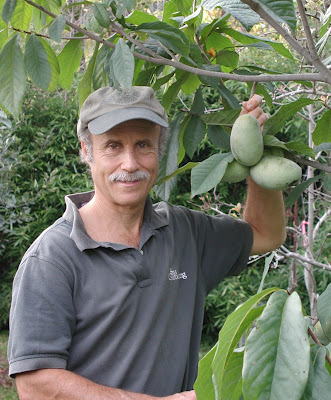 Odd-looking fruits are now prominently dangling from a beautiful tree in my yard. The fruits are odd looking because they seem so out of place here in New York’s Hudson Valley. Tropical! The whole tree, in fact, looks tropical. Large, lush, green leaves — similar in shape to those of the avocado — dangle from the stems and look as fresh now as they did when they first unfolded in spring.
Odd-looking fruits are now prominently dangling from a beautiful tree in my yard. The fruits are odd looking because they seem so out of place here in New York’s Hudson Valley. Tropical! The whole tree, in fact, looks tropical. Large, lush, green leaves — similar in shape to those of the avocado — dangle from the stems and look as fresh now as they did when they first unfolded in spring.That “tropical” is, of course, also part of the appeal of these plants, which are pawpaw trees (Asimina triloba). On a hot summer day, the pawpaw’s lush appearance provides a tropical oasis, psychological and visual, if not actual.
 “Native” might be one reason to grow pawpaws, but there are plenty of others. The pawpaw is very easy to grow; it needs little or no pruning, and pests are rarely a problem, so spraying is unnecessary.
“Native” might be one reason to grow pawpaws, but there are plenty of others. The pawpaw is very easy to grow; it needs little or no pruning, and pests are rarely a problem, so spraying is unnecessary.With its beauty, its delectable fruits, and its ease of growth, the pawpaw is ideal for growing as a landscape plant that also provides food, a practice that I like to call “luscious landscaping.” In my book Landscaping with Fruit, I rate all the landscape-worthy fruits in the book (not all good-tasting fruits are necessarily borne on landscape-worthy plants) from 1 to 3, with 1 being the highest rating. The pawpaw merited a rating of 1.
 The fruit, which begins ripening around mid-September, carries that tropical theme right to its eating. With a creamy texture and whitish flesh, pawpaw fruit has been likened to banana . . . or vanilla custard . . . or banana mango, pineapple, and avocado.
The fruit, which begins ripening around mid-September, carries that tropical theme right to its eating. With a creamy texture and whitish flesh, pawpaw fruit has been likened to banana . . . or vanilla custard . . . or banana mango, pineapple, and avocado.I’ll keep some of that tropical flavor going for a few weeks with fresh pawpaws. I’ll also run some of the flesh through a food mill to sift out the lima bean–sized seeds, then freeze the flesh for winter eating. One of my favorite taste treats is to eat that pawpaw flesh with a sprinkling of the liqueur cassis. Crème brûlée (without the fat and sugar), anyone? No matter how it’s described, the pawpaw fruit tastes tropical and delicious!
To see what's happening in my farmden (more than a garden, less than a farm), check out my blog at http://www.leereich.blogspot.com
Also, check out my article in the September issue of Chronogram, "Backyard Bounty: Permaculture is Taking Root."
Lee Reich, PhD, is an author, lecturer, and consultant whose books include The Pruning Book and Weedless Gardening. Reich grows a broad assortment of fruit plants in his garden, which has been featured in the New York Times, Organic Gardening, and Martha Stewart Living. He lives in New Paltz, New York.
1 comment:
I'm definitely going to look for one of these at an area nursery.
Post a Comment